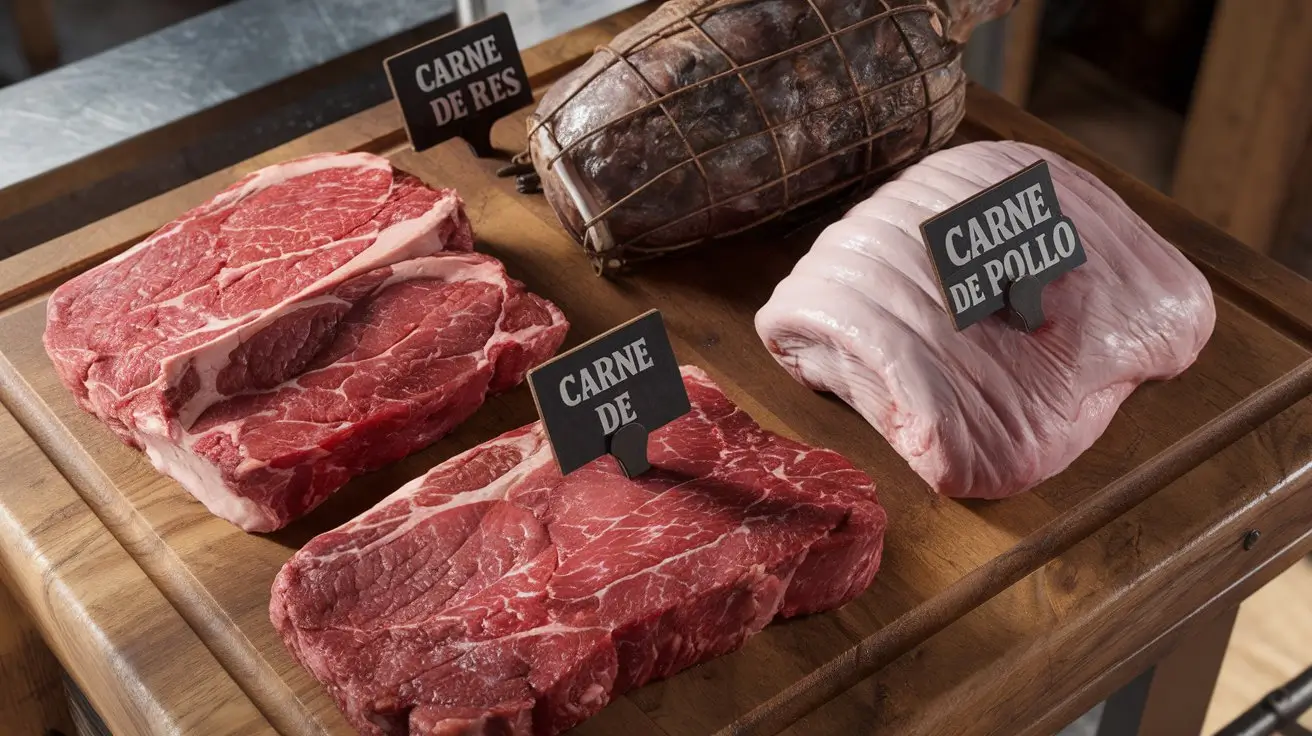Many Spanish learners ask: Does carne mean meat or beef? The truth is, this simple word has different meanings depending on the country. In some regions, carne refers to meat in general, while in others, it specifically means beef. So, when ordering food or shopping for groceries, understanding whether carne means meat or beef can help you avoid confusion! In some Spanish-speaking countries, carne is used broadly to mean meat in general. But in certain regions, when people say carne, they’re actually referring to beef!
So, what determines whether carne means meat or beef? Culture, context, and even regional dialects all play a role. In this article, we’ll break down the different meanings of carne, explore its use in various countries, and clarify common terms like carne de res, carne de vaca, and carne molida.
By the end, you’ll know exactly how to use carne correctly, whether you’re ordering food in Mexico, shopping at a butcher in Spain, or simply expanding your Spanish vocabulary.
Table of Contents
Does Carne Mean Meat or Beef? Understanding Its Meaning in Context
The Etymology of the Word ‘Carne’
The word carne comes from Latin, where it originally meant flesh or body tissue. Over time, its meaning evolved to refer specifically to the flesh of animals used as food. In modern Spanish, carne is most commonly translated as meat, but its exact meaning can vary depending on the situation.
In ancient Rome, the term carnem was used for all types of edible animal flesh. This usage carried over into Romance languages like Spanish, Italian, and Portuguese. However, as food cultures developed, different regions started associating carne with specific types of meat, particularly beef.
Carne as ‘Meat’ vs. Carne as ‘Beef’
So, does carne mean meat or beef? The answer depends on where you are:
- In Spain and some Latin American countries, carne refers to meat in general, including beef, chicken, and even fish. If someone wants to specify a particular type of meat, they’ll say carne de pollo (chicken), or carne de res (beef).
- In Mexico and parts of Central America, carne is commonly used as shorthand for beef. If someone says, “Voy a comprar carne,” they typically mean they’re buying beef, unless they specify another type.
- In Argentina and Uruguay, countries famous for their beef consumption, carne almost always refers to beef. Other meats are named explicitly, pollo for chicken, and pescado for fish.
This difference in meaning can lead to confusion, especially for Spanish learners. If you’re in a Spanish-speaking country and unsure, it’s always best to ask for clarification, just to be sure you’re getting the right kind of meat!
How Different Languages and Cultures Interpret ‘Carne’
‘Carne’ in Spanish-Speaking Countries
In Spanish, the word carne is widely understood to mean meat, but the specifics vary by region. This is one reason why learners often ask: Does carne mean meat or beef?
- In Spain, carne typically refers to meat in a broad sense, including beef, pork, lamb, and even game meats. If you want to order beef specifically, you’ll likely ask for carne de res or ternera (veal).
- In Mexico and many parts of Latin America, carne is often synonymous with beef. If someone says, “Voy a comprar carne para la comida” (I’m going to buy meat for the meal), they most likely mean beef unless they specify otherwise.
- In Argentina and Uruguay, two of the world’s top beef-consuming countries, carne almost always means beef. Other meats are referred to explicitly, like pollo for chicken and cerdo for pork.
This regional variation can cause confusion for travelers and Spanish learners. If you want to explore more Spanish vocabulary for different types of meat, check out this comprehensive guide on meat-related words in Spanish.
How ‘Carne’ Differs in Italian and Portuguese
Since Spanish shares linguistic roots with Italian and Portuguese, carne appears in all three languages. However, its meaning isn’t always the same:
- In Italian, carne refers to meat in general, just like in Spain. If you want to specify beef, you’d say carne di manzo.
- In Portuguese, carne also means meat broadly, but if you want to specify beef, you’d use carne de boi or carne bovina.
While all these languages use carne, its exact meaning can shift depending on the country and context. If you’re ordering food or shopping in a market, knowing these differences can help you avoid misunderstandings.
The Use of ‘Carne’ in Culinary and Everyday Speech
Carne in Mexican and Latin American Cuisine
In the culinary world, carne appears in countless dishes, but it usually refers to beef unless otherwise specified. Here are a few classic Latin American meals where carne plays a central role:
- Carne Asada – Grilled beef, often marinated and served with tortillas, rice, and salsa.
- Carne Molida – Ground beef, commonly used in tacos, empanadas, and picadillo.
- Carne Guisada – A slow-cooked beef stew, rich in spices and vegetables.
- Carne de Res en Salsa – Beef cooked in a flavorful sauce, often served with rice.
While these dishes primarily use beef, pork (carne de cerdo) and chicken (carne de pollo) are also common in Latin American cuisine. The key takeaway? If you see carne on a menu, it’s likely referring to beef, but it’s always good to double-check!
Common Phrases and Expressions Using ‘Carne’
Beyond food, carne appears in many Spanish idioms and expressions. Here are a few you might hear:
- “Estar en carne viva” – Literally “to be in live flesh,” meaning to feel emotionally or physically vulnerable.
- “Poner toda la carne en el asador” – A phrase from Argentina and Spain meaning to give something your all, similar to “put all your eggs in one basket.”
- “Más carne que un asador” – Used humorously to describe someone who is very muscular or well-built.
As you can see, carne isn’t just about food, it’s deeply woven into language and culture. Whether you’re chatting with native speakers or exploring Spanish-speaking countries, understanding these nuances will help you communicate more naturally.
Carne de Res, Carne de Vaca, and Other Specific Terms
What Does ‘Carne de Res’ Mean?
One of the most common terms you’ll hear when talking about beef in Spanish is carne de res. But what exactly does it mean?
The phrase carne de res literally translates to meat of cattle. In Spanish-speaking countries, it’s the standard way to specify beef when ordering food or buying meat at the market. Unlike carne, which can mean different types of meat depending on the region, carne de res always refers to beef.
For example, if you go to a butcher in Mexico and ask for carne, you’ll likely get beef. But if you’re in Spain or another Latin American country, you might need to say carne de res to avoid confusion.
Carne de Vaca vs. Carne Molida: Key Differences
While carne de res is the most common way to refer to beef, you might also hear carne de vaca. However, this phrase is much less common and can sometimes sound unusual to native speakers.
- Carne de Vaca – Literally means meat of cow, but it’s rarely used in everyday conversation. It may sound overly technical or even incorrect in some regions.
- Carne Molida – This means ground beef. If you’re making tacos, burgers, or picadillo, you’ll need to ask for carne molida de res.
So, if you’re in a Spanish-speaking country and need ground beef, don’t say carne de vaca molida, stick with carne molida de res instead!
How to Avoid Confusion When Talking About ‘Carne’
When to Specify the Type of Meat
Since carne can mean both meat and beef depending on the region, it’s always a good idea to be specific. Here are a few tips to avoid misunderstandings:
- If you want beef, say “carne de res” – This ensures you get the right meat, especially in Spain and Latin America.
- For other meats, name the animal – Use carne de cerdo (pork), carne de pollo (chicken), or carne de cordero (lamb).
- Ask for clarification – If you’re unsure, simply ask: ¿Es carne de res o de otro tipo? (Is it beef or another type of meat?).
Regional Variations in Spanish and Their Importance
The meaning of carne shifts based on where you are, so understanding these differences can save you from mix-ups:
- In Mexico and Argentina, carne almost always means beef.
- In Spain and most of Latin America, carne means meat in general.
- In Spain, if you want beef, say ternera (veal) or carne de res.
By keeping these variations in mind, you’ll always know what you’re ordering, whether at a restaurant, market, or butcher shop!
FAQs
Understanding the word carne can be tricky, especially for language learners and travelers. Below, we answer some of the most common questions people ask about its meaning.
Is carne beef or meat?
A common question learners have is: Does carne mean meat or beef? The answer depends on the region. In Spain and many Latin American countries, carne refers to meat in general. However, in Mexico and Argentina, carne is often used as a shorthand for beef.
If you want to be specific, it’s best to use carne de res for beef, carne de pollo for chicken, and carne de cerdo for pork.
What does carne mean in Mexico?
In Mexico, when people say carne, they usually mean beef. If someone invites you to a carne asada, they’re talking about a barbecue featuring grilled beef. However, if you want to refer to other meats, you need to be more specific:
- Carne de res – Beef
- Carne de cerdo – Pork
- Carne de pollo – Chicken
Being aware of this distinction can help you avoid confusion when ordering food or buying meat at the market.
Is carne de res the same as carne molida?
Not exactly! Carne de res simply means beef, while carne molida refers to ground meat. If you want to be specific about ground beef, you should say carne molida de res.
For example:
- Carne de res – Any cut of beef
- Carne molida de res – Ground beef
- Carne molida de cerdo – Ground pork
What kind of meat is carne in Spanish?
In Spanish, carne generally refers to any type of meat. However, its meaning can change depending on the country. If you’re in Spain, carne might include beef, pork, lamb, or chicken. But in Argentina or Mexico, if you ask for carne, you’ll most likely get beef.
Conclusion
So, the final question remains: Does carne mean meat or beef? The answer depends on where you are! In many Spanish-speaking countries, carne refers to meat in general, while in places like Mexico and Argentina, carne often means beef specifically. Now that you know the difference, you can confidently use the word carne when ordering food without any confusion!
If you’re traveling, learning Spanish, or ordering food, it’s always a good idea to specify the type of meat you want. Asking for carne de res instead of just carne can help you avoid confusion, especially in countries where carne is used interchangeably with beef.
Understanding these nuances will make your Spanish conversations smoother, whether you’re at a restaurant, a market, or chatting with native speakers. Now that you know the difference, you can confidently answer when someone asks: Does carne mean meat or beef?

